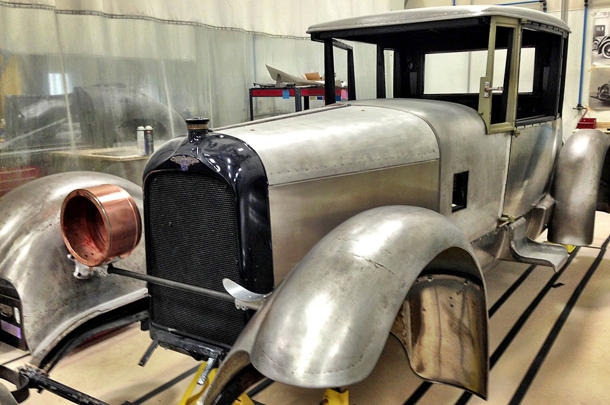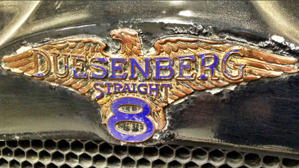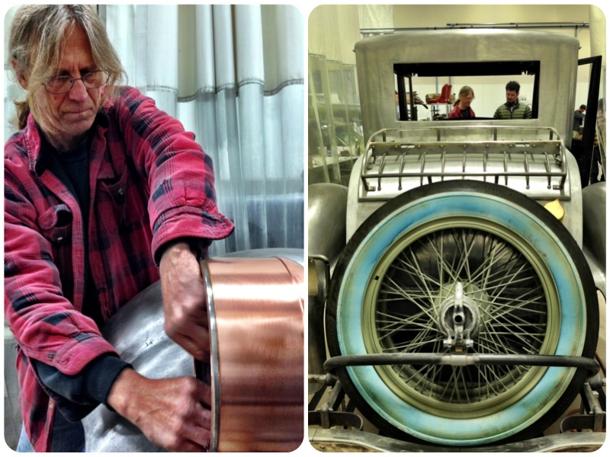On a recent fall morning, business is buzzing at the automotive candy shop that is Canepa Design. Over here, a Ferrari Daytona is having work done on its carbs, over there a vintage Mercedes Benz Gullwing is being stripped of paint. But sandwiched between other familiar sports cars -- a pair of Porsche 356s and a Shelby GT350 -- is a rare bird of a far different feather: The first passenger car to ever wear the name Duesenberg, an important piece of automotive history.
Dave Stoltz, Canepa's one-man restoration crew on this project of a lifetime, is hard at work on this doozy of a car, a 1921 Duesenberg Model A road-rocket that has been in the Castle family -- Hawaiian missionaries turned land and produce magnates -- since new and is being revived by California descendent Jimmy Castle. The car is the first production model of the storied racing-focused brand that later became synonymous with four-wheeled opulence. These visions of American luxury were driven by everyone from Al Capone to William Randolph Hearst, and custom-outfitted cost as much as $25,000 at a time when doctors earned around $3,000 a year.
Canepa Design's mission is to present this one-off car at the 2013 Pebble Beach Concours d'Elegance, just down Highway One from its Scotts Valley, Calif., headquarters. Although in its present state the car looks humble, restored it could well make a 1962 Ferrari GTO that recently traded hands for $35 million look like a cheap date.
"Duesenbergs routinely fetch eight figures, so for this one, the very first production car that's stayed in the same family, the price could well be more than $50 million," says Canepa spokesman John Ficarra, who adds that the restoration alone will cost more than a million, most of it in labor as Stoltz sets about either restoring or manufacturing myriad pieces using as a roadmap just four photos of the car in its heyday.
Not that the car's ultimate asking price matters. Castle doesn't appear to be selling. Duesenberg collector and comedian Jay Leno tried to buy the car a few years back but was politely rebuffed. He remains intrigued by the seminal machine.
"The Duesenberg brothers built racing cars, which eventually gave way to making a few production cars," Leno explains. "This car had a straight 8 (cylinder) engine, which was fairly new at the time, and hydraulic brakes. It was big, heavy and reliable. The first of anything is always significant. It's like a Honus Wagner baseball card. And some cars these days really are moving into the realm of kinetic artwork, investments that aren't unlike buying an early (Marc) Chagall or a Picasso."
What makes this car unique is that despite its massive size it was, relatively speaking, a spry coupe in its day, says Randy Ema, one of the nation's foremost Duesenberg experts who owns what's left of the manufacturer's records and blueprints and has provided some assistance on the restoration.
"The car could hit 80 mph and rev up to 4,000 rpm, which was really unheard of back then," says Ema. "It was a light, nimble little car when compared to a Packard or Lincoln. It also cost $9,000 when a Ford cost around $280. But what makes this model so special is it's the first and only remaining original-owner car."
While this particular Duesenberg isn't accompanied by much documentation save vintage photos, "Fred Roe's book on Duesenberg indicates that it was built and sold before the end of 1921 and that the original owner's assertion that it was the first car sold is probably correct," says Jon Bill, archivist at the Auburn Cord Automobile Museum in Auburn, Ind. (Auburn Automobiles owner E.L. Cord bought Duesenberg in 1926.)
The first thing that strikes you about the car is the size of its two-passenger cabin, which is framed in wood. The oversized dimensions stem from its first owner's massive size, said to be some seven feet tall and three hundred pounds. But changing that seat position is likely the only thing Stoltz will mess with on this car; his mandate is to spare no expense to make the car look like it did the day it left the Duesenberg factory.
"Not long after the first owner bought the car he shipped it to Hawaii, where the lava roads and farm life were very taxing," says Stoltz. "So he eventually shipped it back to the factory, and they beefed things up a lot, all of which we are getting rid of. I now have these four (original) photos ingrained in my head, and I've been making new parts as we go along."
 This rebuild is as complete as they come. Time and the ocean's salt air ate away a good deal of the car's aluminum and steel, and the deterioration was exacerbated by decades of storage in Hawaii and California. So far, Stoltz has hand-fabricated bumpers, parts of fenders, an intricate luggage rack, a brass gas cap, and headlight stands - a part you can barely see once the British-made brass headlamps take up residence on top of them. Stoltz pulls off the stands, two pieces of flowing sculpture that he says could be made using computer technology for around $7,000 but which he crafted from molds for $5,000.
This rebuild is as complete as they come. Time and the ocean's salt air ate away a good deal of the car's aluminum and steel, and the deterioration was exacerbated by decades of storage in Hawaii and California. So far, Stoltz has hand-fabricated bumpers, parts of fenders, an intricate luggage rack, a brass gas cap, and headlight stands - a part you can barely see once the British-made brass headlamps take up residence on top of them. Stoltz pulls off the stands, two pieces of flowing sculpture that he says could be made using computer technology for around $7,000 but which he crafted from molds for $5,000.
"Besides the cheaper price, I liked the fact that they wouldn't be totally perfect, because no one back in 1921 was using computers to make anything," snickers the pony-tailed Stoltz, whose recently helped restore a 1959 Ferrari Testarossa to its former glory. "This is definitely a dream job for me. This Duesy is like a ghost car, because no one has seen it for years. But in the end a car's a car. If you're willing to put in the hours researching, scouring the Web looking for parts, making parts, starting from scratch when you have to, then anything is possible."
At present, the body of this 1921 Duesenberg is waiting to be joined by its suspension and engine, the latter being worked on by fabled Ed Pink Racing Engines in Los Angeles. We'll be back with more as the car comes together.
source: Motoramic
by Marco R. della Cava
by Marco R. della Cava



No comments:
Post a Comment